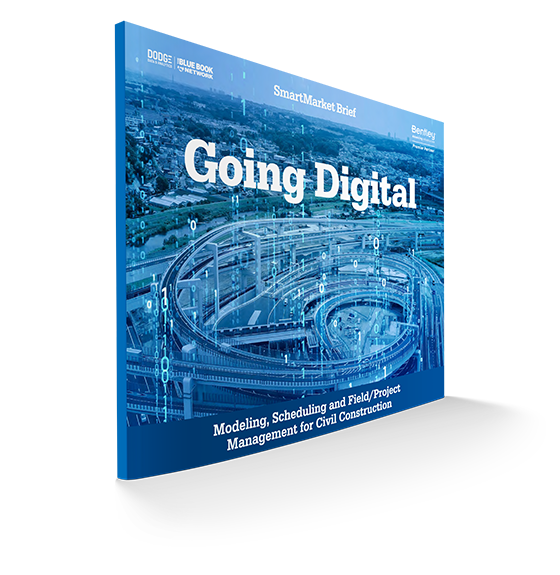

Dodge Data & Analytics and partner Bentley released the first of a two-part report series tied to digital technology strategies amongst civil contractors. This initial report titled, Going Digital: Modeling, Scheduling and Field/Project Management for Civil Construction SmartMarket Brief, takes a specific look at model-based technology and field/project management software. Its findings show that while there is a sizable opportunity for civil contractors to improve their outcomes with wider technology adoption as 39% of civil contractors currently don’t use field/project management software and 66% don’t use model-based technology for their projects. The report explores this and offers ways to help make the tools even more effective in the future.
The use of modeling tools is relatively low, and among those using them, only one automated workflow, model-based quantity takeoff for estimating is widely employed. When reviewing several other workflows (such as simulations for RFP/business development communications or digital as-built handovers to owners), the study found that only about 30%-40% of the respondents actually using model-based technologies currently employ any of these other activities. The contractors who use them consistently, however, report a high level of value derived from them, and once deployed, they use these workflows on the majority of their projects as well.
The study reveals that moderate levels of implementation also still yield critical project outcome benefits, and reduced rework, improved schedule performance, improved stakeholder understanding of the project and improved profitability are frequently among the top benefits achieved through model-based technology. In addition, 83% of civil contractors report a notable impact on the reduction of project schedule delays from the use of these tools.
Those using field/project management software also report a number of benefits:
- 61% report that they get high/very high value out of their projects data.
- While improved schedule performance is a top value driver, improved labor productivity, cost predictability/profitability, and reduced costs are all notable project benefits named.
- 93% experience a medium or higher impact from these tools on the reduction of schedule delays; 34% claim high/very high impact.
- 65% believe that these tools reduce the risk of construction cost overruns.
“We know that the U.S. needs to make major investments in infrastructure over the next few years,” said Steve Jones, Senior Director of Industry Insights Research at Dodge Data & Analytics. “As the amount of work increases and as the workforce and supply chain challenges continue to plague the industry, contractors need ways to maximize their productivity, have dependable schedules, and have reliable levels of profit. The findings of this study demonstrate the ways in which digital technology and resources can serve as key parts of their strategy for success when facing these challenges.”
Users of both model-based technology and field/project management tools believe that they could get more out of these tools if they integrated with other software and digital resources. This supports the increasing need for contractors to move beyond single-point solutions to a more holistic means of incorporating different technologies and the data they contain on their projects.
“As the report indicates, Heavy Civil (horizontal) construction lags behind vertical building projects in its use of model-based and field/mobile technology,” said Richard Humphrey, VP of Product Management. “This may be attributed to the spatial context of civil projects and the nature of how civil design models are created. Adoption of the latest technology from civil contractors and building contractors, however, is proving to help address these problems and realize greater significant efficiencies, keep projects in control, and deliver better project outcomes overall.”
In addition, the study examined the attitudes of those not yet using these tools. Interest in field/project management tools among non-users is particularly high, with 46% thinking about whether to use it frequently, and an additional 17% who are strongly considering using it. Those who are not using model-based technology are a little more cautious, with 45% who think about using it occasionally and 27% who consider it frequently. Most non-users would like to realize the benefits (i.e., improved profitability, reduced cost, improved labor productivity, improved schedule performance and improved cost predictability) from both types of tools in order to more actively pursue implementation.
“As demand for infrastructure increases and projects become more complex, the industry (i.e., contractors) will not be able to deliver and close the gap between supply and demand for infrastructure by doing things the same way,” continued Humphrey. “Civil contractors will need to accelerate their adoption of Model-based and mobile technology to meet these challenges and not get left behind.”
The full report is available for free download at www.construction.com.
